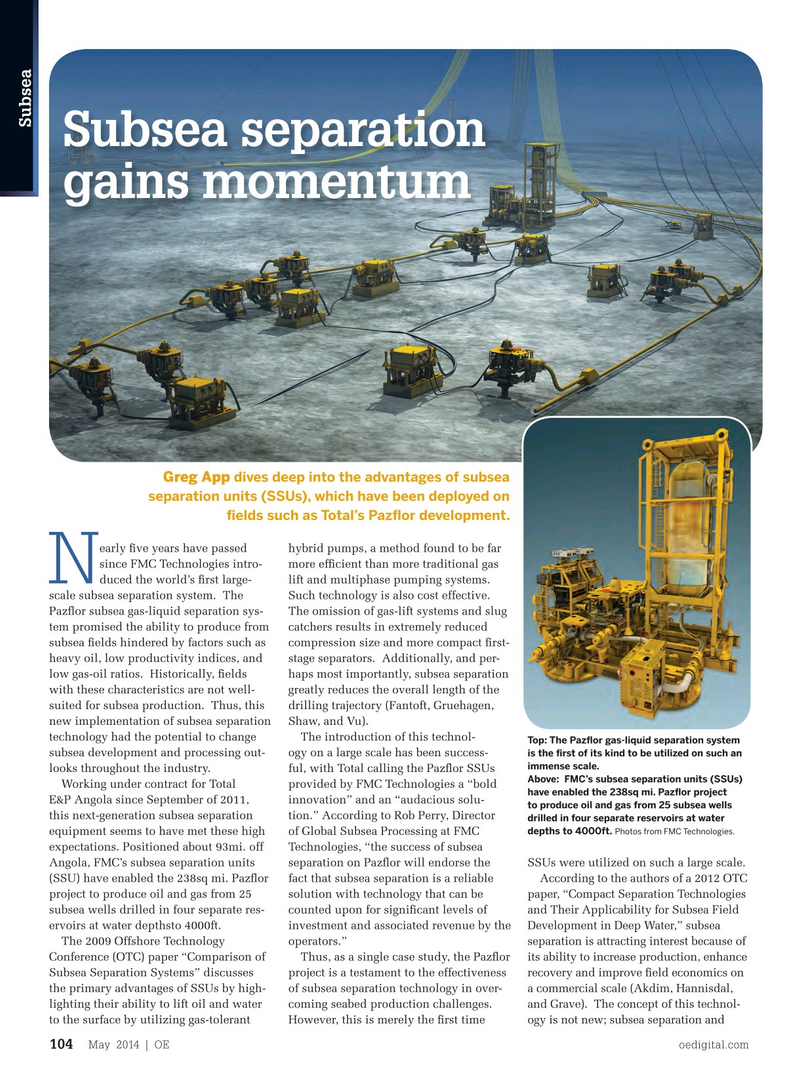
Page 102: of Offshore Engineer Magazine (May/Jun 2014)
Read this page in Pdf, Flash or Html5 edition of May/Jun 2014 Offshore Engineer Magazine
Subsea
Subsea separation gains momentum
Greg App dives deep into the advantages of subsea separation units (SSUs), which have been deployed on ? elds such as Total’s Paz? or development.
early ? ve years have passed hybrid pumps, a method found to be far since FMC Technologies intro- more ef? cient than more traditional gas
N duced the world’s ? rst large- lift and multiphase pumping systems. scale subsea separation system. The Such technology is also cost effective.
Paz? or subsea gas-liquid separation sys- The omission of gas-lift systems and slug tem promised the ability to produce from catchers results in extremely reduced subsea ? elds hindered by factors such as compression size and more compact ? rst- heavy oil, low productivity indices, and stage separators. Additionally, and per- low gas-oil ratios. Historically, ? elds haps most importantly, subsea separation with these characteristics are not well- greatly reduces the overall length of the suited for subsea production. Thus, this drilling trajectory (Fantoft, Gruehagen, new implementation of subsea separation Shaw, and Vu).
technology had the potential to change The introduction of this technol-
Top: The Paz? or gas-liquid separation system subsea development and processing out- ogy on a large scale has been success- is the ? rst of its kind to be utilized on such an immense scale. looks throughout the industry. ful, with Total calling the Paz? or SSUs
Above: FMC’s subsea separation units (SSUs)
Working under contract for Total provided by FMC Technologies a “bold have enabled the 238sq mi. Paz? or project
E&P Angola since September of 2011, innovation” and an “audacious solu- to produce oil and gas from 25 subsea wells this next-generation subsea separation tion.” According to Rob Perry, Director drilled in four separate reservoirs at water depths to 4000ft.
Photos from FMC Technologies.
equipment seems to have met these high of Global Subsea Processing at FMC expectations. Positioned about 93mi. off Technologies, “the success of subsea
Angola, FMC’s subsea separation units separation on Paz? or will endorse the SSUs were utilized on such a large scale. (SSU) have enabled the 238sq mi. Paz? or fact that subsea separation is a reliable According to the authors of a 2012 OTC project to produce oil and gas from 25 solution with technology that can be paper, “Compact Separation Technologies subsea wells drilled in four separate res- counted upon for signi? cant levels of and Their Applicability for Subsea Field ervoirs at water depthsto 4000ft. investment and associated revenue by the Development in Deep Water,” subsea
The 2009 Offshore Technology operators.” separation is attracting interest because of
Conference (OTC) paper “Comparison of Thus, as a single case study, the Paz? or its ability to increase production, enhance
Subsea Separation Systems” discusses project is a testament to the effectiveness recovery and improve ? eld economics on the primary advantages of SSUs by high- of subsea separation technology in over- a commercial scale (Akdim, Hannisdal, lighting their ability to lift oil and water coming seabed production challenges. and Grave). The concept of this technol- to the surface by utilizing gas-tolerant However, this is merely the ? rst time ogy is not new; subsea separation and
May 2014 | OE oedigital.com 104 104_OE0514_Subsea5_Greg.indd 104 4/19/14 9:47 AM

 101
101

 103
103